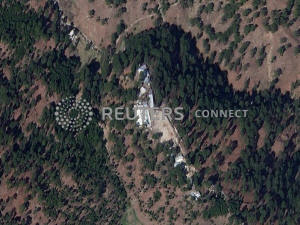|
Satellite images show buildings still
standing at Indian bombing site
 Send a link to a friend
Send a link to a friend
 [March 06, 2019]
By Martin Howell, Gerry Doyle and Simon Scarr [March 06, 2019]
By Martin Howell, Gerry Doyle and Simon Scarr
NEW DELHI/SINGAPORE (Reuters) -
High-resolution satellite images reviewed by Reuters show that a
religious school run by Jaish-e-Mohammad (JeM) in northeastern Pakistan
appears to be still standing days after India claimed its warplanes had
hit the Islamist group's training camp on the site and killed a large
number of militants.
The images produced by Planet Labs Inc, a San Francisco-based private
satellite operator, show at least six buildings on the madrasa site on
March 4, six days after the airstrike.
Until now, no high-resolution satellite images were publicly available.
But the images from Planet Labs, which show details as small as 72 cm
(28 inches), offer a clearer look at the structures the Indian
government said it attacked.
The image is virtually unchanged from an April 2018 satellite photo of
the facility. There are no discernible holes in the roofs of buildings,
no signs of scorching, blown-out walls, displaced trees around the
madrasa or other signs of an aerial attack.
The images cast further doubt on statements made over the last eight
days by the Indian government of Prime Minister Narendra Modi that the
raids, early on Feb. 26, had hit all the intended targets at the madrasa
site near Jaba village and the town of Balakot in Pakistan's Khyber
Pakhtunkhwa province.
India's foreign and defense ministries did not reply to emailed
questions sent in the past few days seeking comment on what is shown in
the satellite images and whether they undermine its official statements
on the airstrikes.

MISSED THE TARGET?
Jeffrey Lewis, director of the East Asia Nonproliferation Project at the
Middlebury Institute of International Studies, who has 15 years'
experience in analyzing satellite images of weapons sites and systems,
confirmed that the high-resolution satellite picture showed the
structures in question.
"The high-resolution images don't show any evidence of bomb damage," he
said. Lewis viewed three other high-resolution Planet Labs pictures of
the site taken within hours of the image provided to Reuters.
The Indian government has not publicly disclosed what weapons were used
in the strike.
Government sources told Reuters last week that 12 Mirage 2000 jets
carrying 1,000 kg (2,200 lbs) bombs carried out the attack. On Tuesday,
a defense official said the aircraft used the 2,000-lb Israeli-made
SPICE 2000 glide bomb in the strike.
A warhead of that size is meant to destroy hardened targets such as
concrete shelters.
Lewis and Dave Schmerler, a senior research associate at the James
Martin Center for Nonproliferation studies who also analyses satellite
images, said weapons that large would have caused obvious damage to the
structures visible in the picture.
"If the strike had been successful, given the information we have about
what kind of munitions were used, I would expect to see signs that the
buildings had been damaged," Lewis added. "I just don't see that here."
Pakistan has disputed India's account, saying the operation was a
failure that saw Indian jets, under pressure from Pakistani planes, drop
their bombs on a largely empty hillside.
"There has been no damage to any infrastructure or human life as a
result of Indian incursion," Major General Asif Ghafoor, the director
general of the Pakistan military's press wing, in a statement to
Reuters.
"This has been vindicated by both domestic and international media after
visiting the site."
BOMB CRATERS
In two visits to the Balakot area in Pakistan by Reuters reporters last
Tuesday and Thursday, and extensive interviews with people in the
surrounding area, there was no evidence found of a destroyed camp or of
anyone being killed.
[to top of second column]
|

A cropped version of a satellite image shows a close-up of a madrasa
near Balakot, Khyber Pakhtunkhwa province, Pakistan, March 4, 2019.
Picture taken March 4, 2019. Mandatory credit: Planet Labs
Inc./Handout via REUTERS

Villagers said there had been a series of huge explosions but the
bombs appeared to have landed among trees.
On the wooded slopes above Jaba, they pointed to four craters and
some splintered pine trees, but noted little other impact from the
blasts that jolted them awake about 3 a.m. on Feb. 26.
"It shook everything," said Abdur Rasheed, a van driver who works in
the area.
He said there weren't any human casualties: "No one died. Only some
pine trees died, they were cut down. A crow also died."
Mohammad Saddique from Jaba Basic Health Unit and Zia Ul Haq, senior
medical officer at Tehsil Headquarters Hospital in Balakot said they
had seen no casualties.
POLITICAL FIRE
India must hold a general election by May, and pollsters say Modi
and his Hindu nationalist party stand to benefit from his aggressive
response to a suicide bomb attack that killed 40 Indian paramilitary
police in the disputed Kashmir region on Feb. 14.
India's Foreign Secretary Vijay Gokhale said on the day of the
strike that "a very large number of Jaish-e-Mohammad terrorists,
trainers, senior commanders, and groups of jihadis who were being
trained for Fidayeen action were eliminated" in the attack. Fidayeen
is a term used to describe Islamist militants on suicide missions.
Another senior government official told reporters on the same day
that about 300 militants had been killed. On Sunday the president of
the ruling Bharatiya Janata Party (BJP), Amit Shah, put the number
killed at more than 250.
The Indian government has not produced evidence that a camp was
destroyed or that any militants were killed in the raid.
That has prompted some opposition politicians to push for more
details.
"We want to know how many people actually died," said Mamata
Banerjee, the firebrand chief minister of West Bengal state, in a
video published by her All India Trinamool Congress party in a tweet
on Feb. 28. "Where did the bombs fall? Did they actually fall in the
right place?"
Banerjee, who is seen as a potential prime ministerial candidate,
said that she stood behind the Indian Armed Forces, but that they
should be given a chance to speak the truth.
"We don't want a war for political reasons, to win an election," she
said.
Modi has accused the opposition Congress party, and other opponents
such as Banerjee, of helping India's enemies by demanding evidence
of the attacks.

"At a time when our army is engaged in crushing terrorism, inside
the country and outside, there are some people within the country
who are trying to break their morale, which is cheering our enemy,"
Modi said at an election rally on Sunday.
(Additional reporting by Abu Arqam Naqash in BALAKOT; Asif Shahzad
and James Mackenzie in ISLAMABAD; Devjyot Ghoshal in New Delhi;
Editing by Alex Richardson)
[© 2019 Thomson Reuters. All rights
reserved.]
Copyright 2019 Reuters. All rights reserved. This material may not be published,
broadcast, rewritten or redistributed.
Thompson Reuters is solely responsible for this content. |